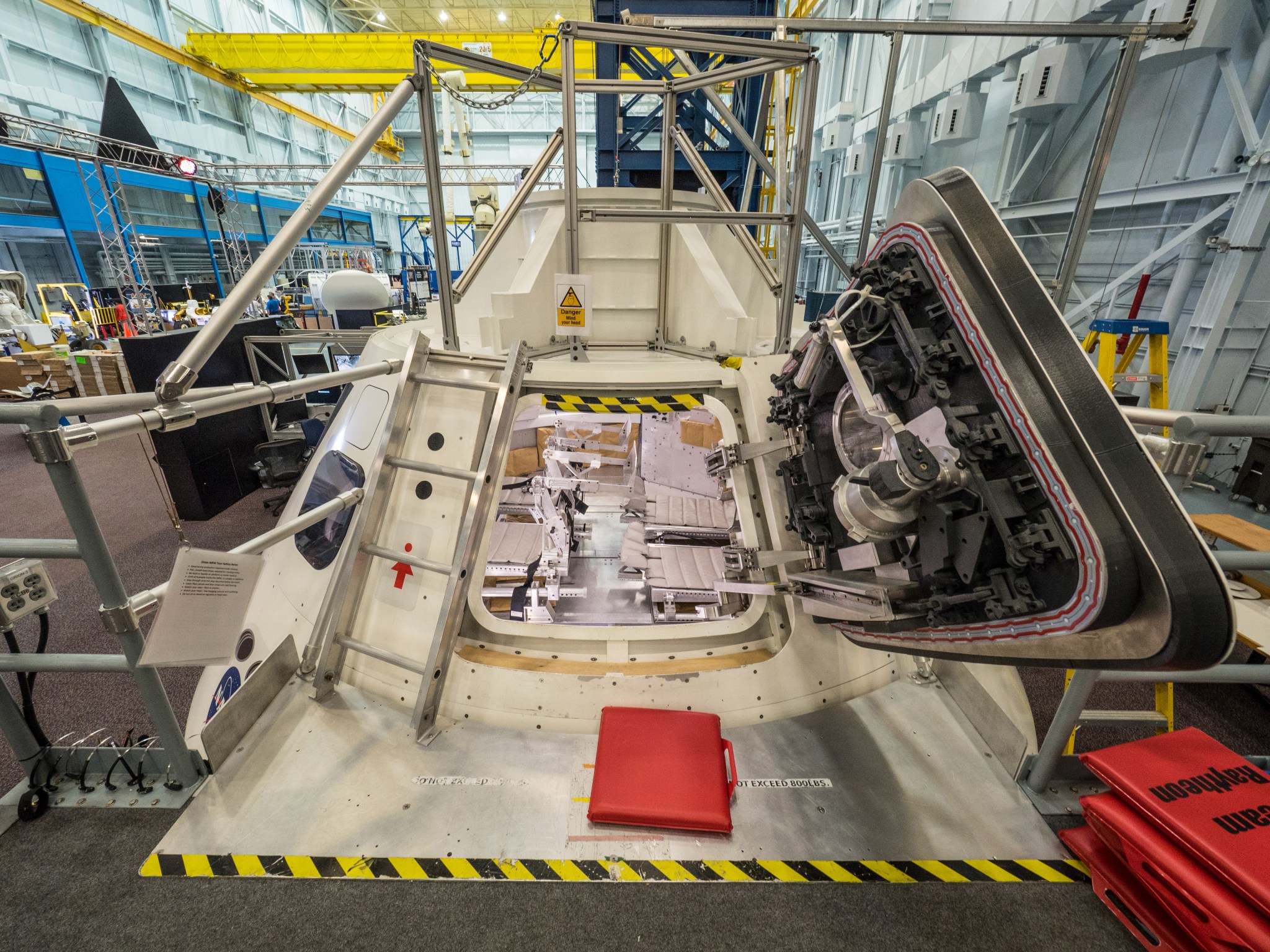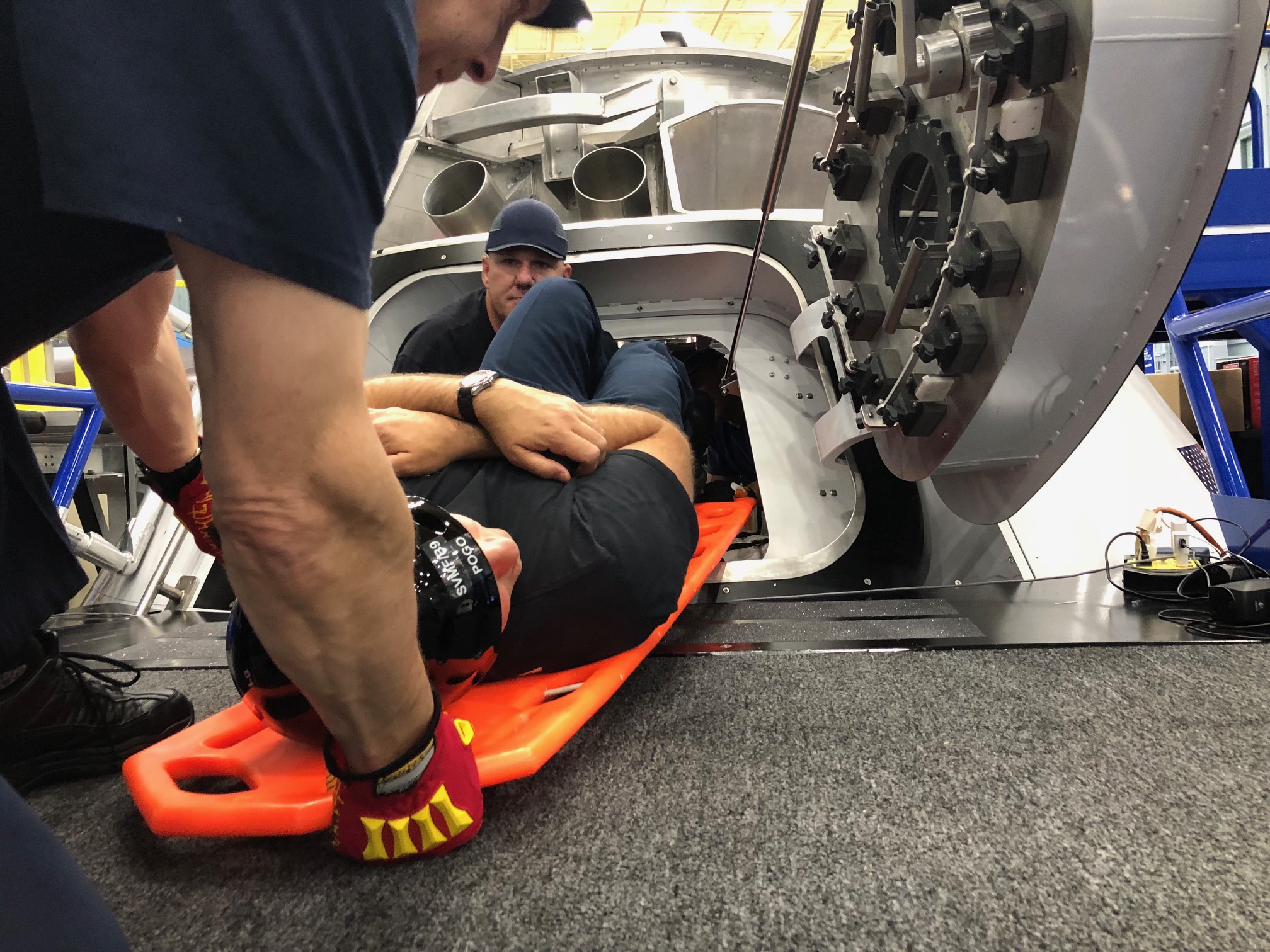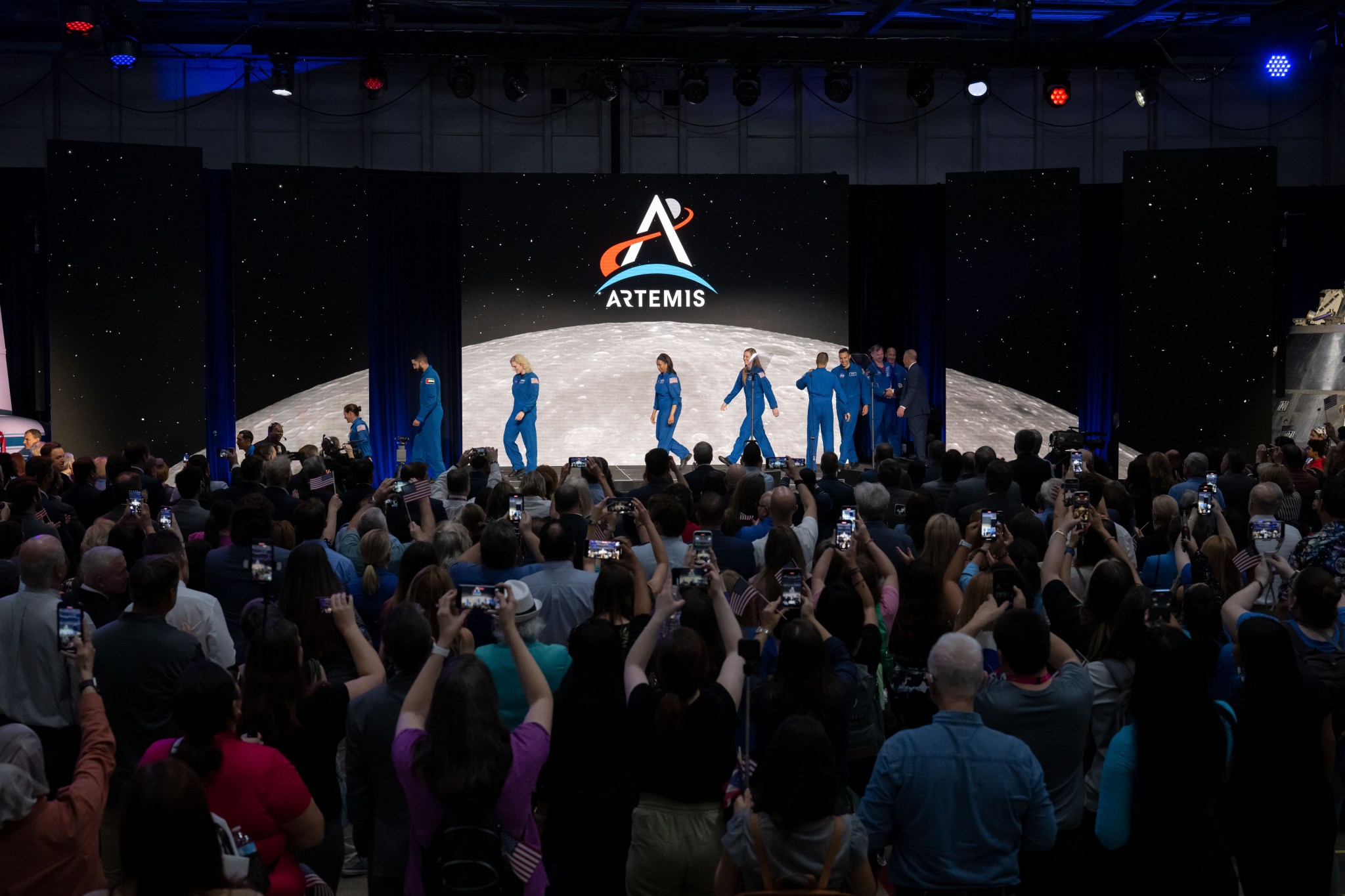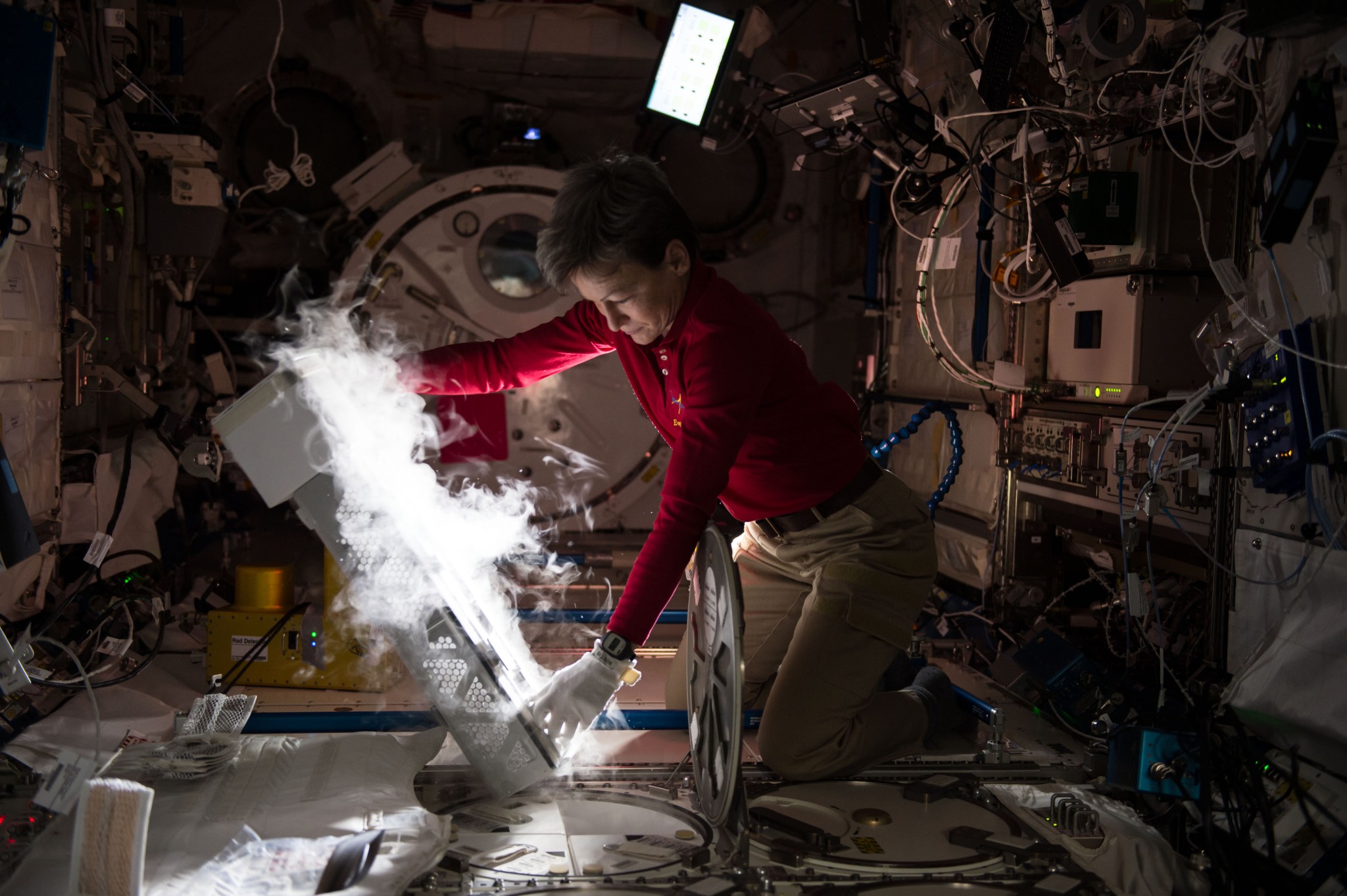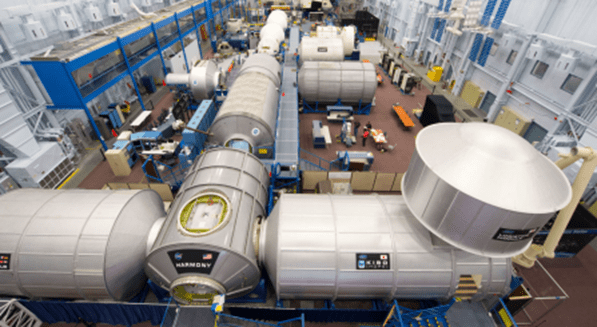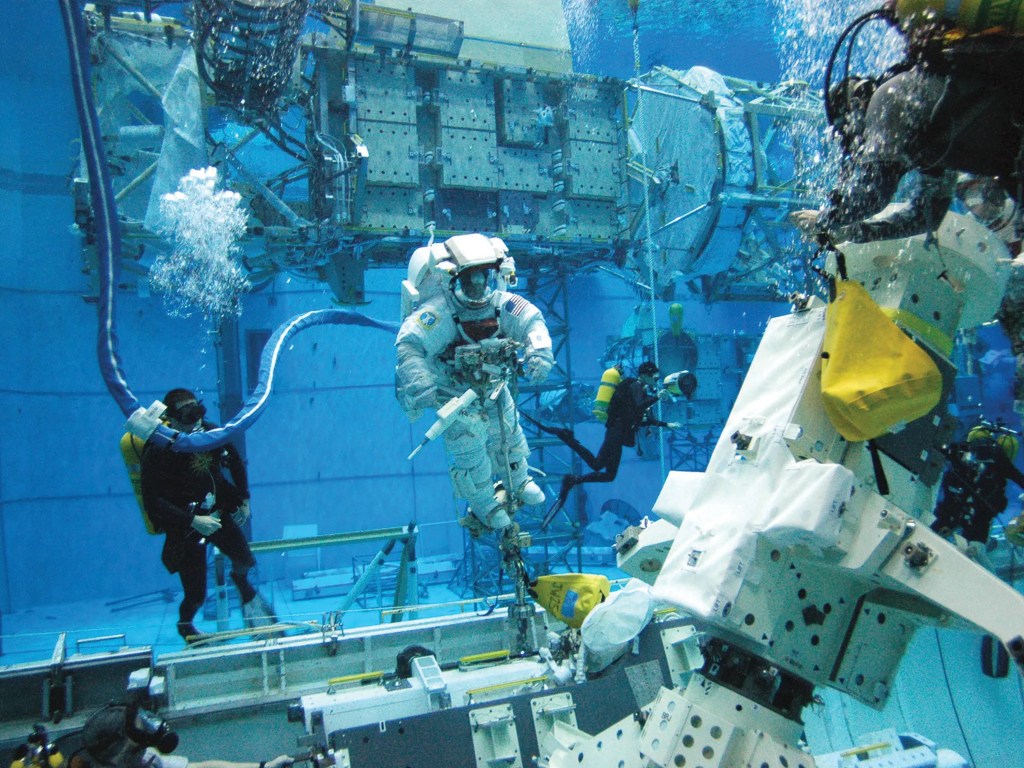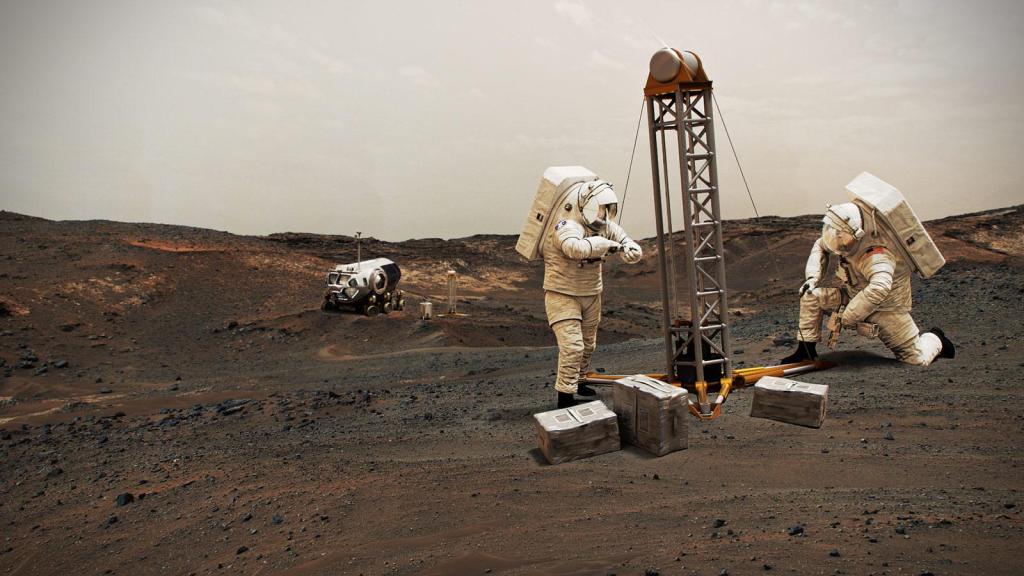Spaceflight Operations
The first word uttered by astronauts in space before history is made – big or small – is “Houston…” NASA’s Johnson Space Center (JSC) has served as the iconic setting to some of humankind’s greatest achievements, including the Apollo Moon landings and the Space Shuttle Program. JSC, a world leader in human spaceflight, has developed unique knowledge, skills, and capabilities over our decades-long experience operating human spacecraft.
JSC serves as a central hub for NASA’s human spaceflight operations, encompassing astronaut training, the Mission Control Center (MCC), International Space Station (ISS) operations, Commercial Crew and Cargo operations, operations considerations for spacecraft development, and ongoing support for new exploration space missions. Our MCC houses some of the world’s most experienced flight controllers and mission support personnel. These individual undergo rigorous training and have a deep understanding of spacecraft systems, procedures and emergency protocols. They provide real-time monitoring, analysis, and decision-making support for crewed space missions. While the MCC serves as the central nervous system for spacecraft operations, ensuring the safety and success of astronauts in space, it also serves as a hub for international collaboration, supporting missions not only for NASA, but also for other space agencies. We continually evolve our technology, procedures and infrastructure to adapt to changing mission requirements and advancements in space exploration, staying at the forefront of innovation in mission control operations. Overall, JSC’s MCC stands as a symbol of human ingenuity, collaboration, and dedication to exploring the cosmos and we invite our partners to join us on the journey. Explore our capabilities below to see where we can advance the boundaries of space exploration and innovation together.
Flight Operations
Mission Control Center (MCC)
NASA Johnson Space Center is the worldwide leader in human spaceflight mission planning, training, test, and flight operations. The Mission Control Center (MCC) at JSC has unparalleled experience in supporting human spaceflight operations.
- 20+ years of accumulated on-orbit Mission Elapsed Time executing spaceflight operations
- More than 300 manned missions and 300+ Extravehicular Activities supported
- World class systems for mission design, test, training, command and control
- Full suite mission planning for ground, crew, and spacecraft communications and trajectory
- Terrestrial, low earth orbit, and deep space communications networks
- Robust and flexible intercom between flight controllers, vehicles, and remote locations
- Studio quality video backbone
- Designed for centralized or distributed operations support
- Reconfigurable command and control
- Key sub functions include Core Software, Application Software, and Recon Product Generation
- Scalable, redundant data and power systems
- Built on standardized interfaces
- Full life-cycle data storage and retrieval
- Fully integrated cyber and data security
- Fully capable off-site backup command and control system
- Support for simulation, vehicle test, flight follow, and playback
- Pre-flight, launch, landing, contingency, and recovery support
- Full mission life cycle weather support
- Ground systems and vehicle operations experts
- Proven ability to concurrently operate diverse, multi-class, multi-mission space vehicles
- Current Programs supported: International Space Station (ISS), Commercial Crew Program (CCP), SpaceX-Dragon, Orbital Cygnus, Boeing CST-100, Orion, and the Space Launch System
For further information, please see: https://www.nasa.gov/johnson/jsc-mission-control-center/
Mission Support Rooms/Operations Suites
The Mission Control Center (MCC) at JSC is designed to enable the configuration of multiple control rooms to support short or long duration dedicated activities. The MCC’s architecture is designed to support multiple simultaneous events with different partners and interfaces.
- Ground systems expert support to facilitate any unique development and integration tasks
- MCC consoles and control rooms can be reconfigured based on activity needs (simulation, test, real-time execution)
- MCC scheduling process enables the team to account for both hardware and network resources when scheduling events
- Available command and control includes communication, command, voice, video, timing, data record/archive, and other real-time capabilities
- Terrestrial, low earth orbit, and deep space communications networks
- Fully integrated cyber and data security
- Redundant data and power systems
- Support for simulation, vehicle test, flight follow, and playback
- Pre-flight, launch, landing, contingency, and recovery support
Flight Control/Mission Execution
NASA JSC Flight Operations Directorate (FOD) flight controllers monitor and control all space flight phases for multiple crewed space vehicles. Mission execution is the culmination of all integrated support functions, flight planning and design, analysis and procedure development, and crew and flight controller training. Crew and flight controller teams work in tandem to execute all mission objectives safely and successfully.
Flight systems control and management of: communications, computers/data, electrical, environmental control/life support, thermal, mechanical, propulsion, guidance and navigation, crew system, photo/TV, etc.
- Real-time operational support for all space flight phases: ascent, orbit/transit, docking, surface operations, entry and landing
- Nominal, contingency, and emergency operations execution
- Real-time planning and execution of daily operations
- Negotiate operational constraints with international partners, scientists and system experts to meet programmatic requirements
- Management and execution of vehicle trajectory plan and altitude strategy
- Proximity operations trajectory/rendezvous operations
- Real-time analysis of vehicle conjunctions and debris avoidance operations/maneuvers
- Real-time operations coordination with International Partner and other control centers
- Visiting vehicle (to orbital space station) operations integration
- Stowage and cargo transfer operations
- Vehicle system performance analysis, maintenance, and repair
- Vehicle commanding and uplink
- Extravehicular activity execution and real-time systems management
- Robotics operations
Worldwide Connectivity
Mission Control Center (MCC) provides worldwide connectivity as the central hub of communications for all human space flight operations.
- Worldwide network and communications connectivity support spacecraft operations
- Space Network Communications
- Low Earth Orbit (LEO)
- Near Earth Network (NEN)Deep Space Network (DSN)
- Tracking Infrastructure & Services
- Tracking and Data Relay Satellite System (TDRSS) & Scheduling
- Local Ground Station / Electronic System Test Laboratory (ESTL)
- Flight Dynamics Facility (FDF)S-Band Radiometric
- C-Band Trackers
- Interconnectivity to all NASA centers
- Connectivity with Vehicle Trainers, Flight Software (FSW), and Science Labs; International Space Station (ISS); Spacecraft System Test (SST), Integrated Test Rig (ITR), Software Development & Integration Laboratory (SDIL), Payload Operations Integration Center (POIC), Multi-Purpose Crew Vehicle/Space Life Sciences (MPCV/SLS), Integrated Test Lab (ITL), Engineering Data Library (EDL), operations and checkout (O&C), Space Systems Integration and Test Facility (SITF), System Integration Laboratory (SIL)
- Integration with Partner Control Centers: Canadian Space Agency (CSA), European Space Agency (ESA) – European Space Technology Center (ESTEC), Columbus Control Center (COL-CC), Italian Space Agency (ASI), Huntsville Ops Support Center (HOSC), Japanese Space Agency (JAXA), Orbital (Dulles), Russian Space Agency (TsUP), SpaceX (Hawthorne)
Operations Integration
NASA JSC Flight Operations Directorate (FOD) utilizes our operational expertise to support operational integration across programs and vehicles. Operational integration is necessary to ensure commonality and synergistic solutions among different elements. Cross program operations integration ensures that design decisions are made appropriately across multiple programs.
- Identify and assess cross-program and vehicle/element risks
- Ensure operational issues are integrated across all impacted stakeholders
- Concept of Operations and System Definition, Test and Certification Plans
- Development of notional timelines to help define and evaluate mission proposals
- Crew displays, interface development, integration and testing
- Spacecraft integration for proximity operations and docking
- Software and hardware limitations resolution and operational workaround design
- Telemetry/downlink definition and integration
- Payload command / telemetry and displays
- Master Verification Plan, Test & Verification Matrix, Verification Closure Notices
Medical and Science Operations
Space Medicine Operations
JSC provides specialized primary medical care for astronauts and expert medical and biomedical engineering support for all human spaceflight mission operations. JSC space medicine performs medical and behavioral selection and certification for flight, as well as surveillance care for former astronauts supported by the JSC spaceflight pharmacy and the wealth of data held by its spaceflight epidemiology group.
Clinical and Space Occupational Medicine
- Behavioral Health and Performance
- Medical and Behavioral astronaut Selection and Certification for Flight
- Hyper and Hypobaric Medicine
- Biomedical Engineering/biomedical Flight controllers
- Space Medicine Subject Matter Expertise
- Astronaut Strength, Conditioning, and Rehabilitation
- Missions Operations and Product Development for Medical Operations
- Space Radiation Analysis
- Spaceflight Epidemiology and Surveillance
- Spaceflight Pharmacy
- Eye Exam & Vision Testing
Science Support
NASA JSC Astromaterials and Exploration Research Division (ARES) pioneered science operations for human missions through support to the Apollo missions, which has been leveraged to all subsequent crewed missions, including International Space Station (ISS) missions, Orion missions, commercial crewed missions, and planned Artemis and Gateway missions.
The Astromaterials and Exploration Science Division (ARES) leads the acquisition of Earth imagery by astronauts. We participate in Mars mission teams, including the Curiosity, Opportunity, and Perseverance rovers. We also integrate into science teams for asteroid missions including Origin’s Spectral Interpretation Resource Identification Security Regolith Explorer (OSIRIS-REx) and Hayabusa2. We lead the geology training of crew for Artemis missions; develop data products for assessment of potential lunar landing sites and surface traverse planning; develop visualization and operational software for crewed mission support; develop engineering and science imagery requirements for current and planned lunar and cis-lunar spacecraft, vehicles, and crew suits; and lead science and sample return planning for lunar landers, rovers, and crew EVAs. We support development of sensors and instruments to enhance the scientific return of planetary exploration, leveraging the International Space Station as a proving ground as needed. We perform routine imagery surveys and analysis of the International Space Station and visiting spacecraft for assessment of vehicle health and safety as well as supporting anomaly investigations when needed. ARES also supports TOPO in assessing the risk from breakups to ISS, EVA, Orion and other crewed missions. Additionally we provide technical assessments supporting spaceflight operations with micrometeoroid orbital debris risk assessments (ISS, EVA, Orion, Gateway, etc.) that directly support design and operations for spacecraft. ARES also curates all astromaterials collected by NASA and international partners.
Additional details are available at https://ares.jsc.nasa.gov/
Tele Science Center
The Tele Science Center (TSC) provides a separate mission control room in the Houston Mission Control Center that allows for privatized video and communications to support NASA’s Human Research Program sponsored investigations.
Digital Voice Inter-Communications Equipment (DVICE) access
- Command path to Human Research Facility through Marshall Space Flight Center Payload Operations Center
- Live Station video
- Ability to Privatize Comm and video from ISS
- Realtime ISS telemetry
- Backup power from standby Generator
- MSE and MCE workstations
Decompression Sickness Mitigations
Johnson Space Center is a hub for decompression sickness research and management. Resident experts exist within research and operational aerospace medicine, dive medicine, dive physiology, decompression physiology, and exercise physiology, as well as a wide variety of engineering disciplines, including computer science and space suit engineering. This expertise coupled with cutting edge technology development enables NASA to implement leading prevention and treatment modalities for decompression sickness, not only in the operational high altitude and space environments, but in the diving environment as well.
Johnson Space Center utilizes state of the art software systems to help experts better understand decompression physics and physiology by modeling tissue absorption of inert gases such as nitrogen, nitrogen bubble formation, and nitrogen offgassing during decompression. These analyses enable NASA to better assess the risk of decompression sickness during Center Operations and to help minimize and mitigate such risks. This includes the development of pre-breathe protocols to reduce risk of decompression sickness during extravehicular activities or during suit testing and the development of operational procedures to minimize decompression sickness risk during extravehicular activity training at the Neutral Buoyancy Laboratory (NBL).
- Pre-Diving Medical Risk Assessment and Mitigation
- Operational Medical Support
- Emergency Medical Response Procedures and Capabilities
Cold Stowage
The Cold Stowage team is part of the International Space Station (ISS) Program. JSC manages the operation, support and integration tasks provided by Jacobs Technology and the University of Alabama Birmingham (UAB). Cold stowage provides controlled environments to meet temperature requirements during ascent, on-orbit operations, and return, in relation to ISS payload science.
NASA’s vision for humans pursuing deep space flight involves the collection of science in low earth orbit aboard the ISS. As a service to the science community, JSC has developed hardware and processes to preserve collected science on the ISS and transfer it safely back to the Principal Investigators. These active and passive cold stowage systems include an array of freezers, refrigerators, and incubators. JSC’s Cold Stowage Lab can perform hold tests, fit checks, and thermal tests by request. Equipment in the lab allows the team to test articles at temperatures ranging between -196° C to +200° C. Cold Stowage also utilizes labs at Kennedy Space Center (KSC) and other vehicle processing locations. The team provides support to payload developers through launch, on-orbit operations, and landing.
Nutritional Biochemistry Laboratory
The primary goal of the Nutritional Biochemistry Laboratory is to keep crews healthy from a nutrition perspective on space missions. This includes determining the nutritional requirements for extended-duration spaceflight, and to develop, evaluate, and validate nutritional countermeasures to prevent or minimize the negative effects of long-duration spaceflight on the human. The activities cover both operations and research efforts. The primary operational activity is the support of the Clinical Nutritional Assessment profile, which includes biochemical assessments before and after International Space Station flights, along with dietary intake and body mass monitoring during these long-duration (4 to 6 month) missions. In addition to general dietary intake issues, several specific nutrients are also of concern, including vitamin D, folate, calcium, iron, and more.
The role of nutrition in physiologic systems (e.g., bone, muscle, cardiovascular, ocular, and immune) during spaceflight is critical, as is the role in behavioral health and performance.
- Performing scientific expertise and support for nutrition-related research and studies of the role of genetics on nutritional requirements
- Collaborating and contributing to writing proposals and scientific articles
- Performing analysis of nutritional, biochemical and physiological markers (e.g., bone markers)
- Performing crew training on nutrition/diet
- Collecting/analyzing dietary intake data
- Providing dietary counseling
- Developing, evaluating and validating of nutritional countermeasures and technologies
- Collaborating with space food scientists to provide dietary and nutritional requirements for space food products tailored for each design reference mission
- Clinical nutritional assessments
- Research study coordination
Radiation Monitoring, Protection and Exposure Analysis
The Space Radiation Analysis Group (SRAG) offers many unique capabilities at the intersection of technology development, data analysis, statistics, information technology, health care, and radiation safety. It deals with the resources, devices, and methods required to predict, monitor, and minimize crew radiation exposure.
Console Monitoring and Support
Johnson Space Center (JSC) has more than 50 years of operational spaceflight experience and provides round-the-clock solar radiation environment monitoring for human spaceflight operations support. SRAG also routinely participates in flight rule development; alert warning systems integration; and space weather forecast modeling. These four capabilities will help JSC ensure safe human spaceflight operations in the upcoming exploration missions beyond Low Earth Orbit.
Radiation Testing and Logistics
JSC routinely coordinates and conducts radiation instrument measurements at various medical and accelerator facilities around the world. These measurements are used for instrument calibration, algorithm development, requirements verification, and multi-instrument comparisons.
Radiation Monitoring and Measurements
JSC has unique expertise and capabilities to assess extreme environment operations, dosimetry, radiation environment measurements, and design and shielding analyses with a very strong reliance on information technology as well as leveraging technology development in radiation detection. JSC offers personal radiation exposure monitoring using personal active detectors. JSC also performs intra- and extra-vehicular radiation environment monitoring and characterization using many passive and active detectors (ranging from micro-dosimeters to charged/neutral particle spectrometers). Currently, JSC is utilizing the International Space Station (ISS) as a development/ certification testbed for future exploration-class instrumentation that will enable high fidelity measurements in simultaneous low mass/low power configurations.
Discipline Specific Operations
Range Safety
Flight Operations Directorate (FOD) Flight Dynamics enables the execution of dynamic spacecraft operations for safe and successful human spaceflight missions.
- Range Safety analysis, flight rules, and tailoring of criteria for rocket launches and spacecraft reentry
- Assessment of public risk for re-entry or breakup of spacecraft
Navigation and Orbit Determination
Flight Operations Directorate (FOD) Flight Dynamics enables the execution of dynamic spacecraft operations for safe and successful human spaceflight missions.
- Orbit determination and spacecraft navigation updates for low earth orbit and cis-lunar space
- Utilization of C-band, TDRS, and Deep Space Network for spacecraft navigation
- Specialized tools for high-speed C-band tracking
Spacecraft Pointing and Attitude Determination
Flight Operations Directorate (FOD) Flight Dynamics enables the execution of dynamic spacecraft operations for safe and successful human spaceflight missions.
- Spacecraft attitude determination utilizing onboard sensors for star tracking and inertial measurement
- Spacecraft attitude analysis to meet thermal, power, or other spacecraft requirements
- Sensor pointing to meeting specific earth or lunar targeting requirements
Trajectory Design/Special Analysis
Flight Operations Directorate (FOD) Flight Dynamics enables the execution of dynamic spacecraft operations for safe and successful human spaceflight missions.
- Flight dynamics expertise provided across multiple programs and vehicles, always incorporating the crew perspective
- Development of launch windows, the ascent profile, ascent abort mode boundaries and representative abort trajectories
- Trajectories and impact predictions for launch vehicle stages and orbital insertion targets
- Deorbit opportunities, deorbit maneuvers, crew module to system module separation maneuvers and impact predictions
- Entry interface targets and entry corridors, and entry profiles for targeted landing sites
Rendezvous and Proximity Operations (RPO)
NASA JSC has expertise in Rendezvous & Proximity Operations (RPO) Guidance Navigation & Control (GN&C) and trajectory design, development, analysis and operations. RPO enables the execution of dynamic spacecraft operations for safe and successful human spaceflight missions.
NASA JSC performs systems requirement definition, analyses, design and testing necessary to support the development of rendezvous, proximity operations and docking (RPOD) Guidance Navigation & Control (GN&C) systems and to verify the compatibility of the designs with functional and performance requirements. We also provide operational considerations such as:
- Development of rendezvous techniques and manual piloting procedures
- Astronaut training for rendezvous and proximity operations
- Development of rendezvous techniques and manual piloting procedures
- Collision avoidance tools and techniques for spacecraft rendezvous and proximity operations
- Rendezvous maneuver plans and spacecraft separation maneuvers
Crew Exercise On-Orbit Systems Management
JSC is the world leader for providing sustaining engineering and systems management for exercise devices.
Exercise Flight Systems Operations
- Data collection and analysis
- Life tracking, sparing inventory and manifesting
- Preventive and corrective maintenance plans and procedures development
- Risk management
- In-flight anomaly investigation, troubleshooting and resolution
- Flight readiness assessments
Device Sustaining Engineering and Systems Management on ISS
- Treadmills (TVIS and T2/COLBERT)
- Bike (CEVIS)
- Resistive Exercise (IRED and ARED)
- Health Monitoring (BP/ECG and Heart Rate)
- Vibration Isolation and Stabilization (VIS)
Robotics Sustaining Engineering for Human-Rated Space Vehicles
Expertise is available in maintaining a safe efficient robotic capability to maximize science and robotic operational life and sustaining engineering and systems management for on-orbit robotics, including these on ISS, Gateway, and Low-Earth Orbit vehicle providers.
- Robotic Mission Planning Review (Procedure review/update, Flight Rules, etc.)
- Real-time robotics system expertise for nominal and off-nominal operations
- Anomaly investigation and resolution of technical issues with robotic systems and interfaces to dependent systems
- Define, update, and maintain robotic system requirements and verifications
- Review change proposals, waivers, deviations, and exceptions
- Perform trending of robotics systems health
- Integration support with external equipment
- Provide software build feature/capability priorities to robotic SW designers (in house or out)
- Testing and evaluation of payloads for robotic compatibility (including Flight Support Equipment and latching)
- Perform Berthing Camera/Target System implementation tasks for Visiting Vehicles and payload, including overlay development
- Visiting Vehicle robotic development support
- Integration of payloads as pertains to robotic compatibility
- Development of robotics requirements for payload handling
- Review exceptions to requirements and initial verification products
- Coordinate issues/concerns/questions with SMEs
- Review verification submittals
- Coordinate operations
- Robotics Human-Machine Interface
- Develop some integrated SW that utilizes vehicle telemetry to report data to users in intuitive ways
- Develop SW to assist operators in development of on-console products
Related Patents
Robonaut 2: Logistics and Distribution
Smart Enclosure using RFID for Inventory Tracking
Wearable RFID Sensor Tags Yield Extended Operational Times
Related Software
Generic Command and Telemetry Applications for the Core Flight Software Framework (CI-TO)






























